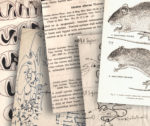Una especie nueva de Oxymycterus (Cricetidae: Sigmodontinae: Akodontini) del sureste de Perú
Horacio Zeballos, César Medina, Adriana Rico-Cernohorska, Jorge Salazar-BravoDescribimos una nueva especie del género Oxymycterus Waterhouse, 1837, de los altos Andes de Cusco en el sureste del Perú, basados en información molecular (citocromo b), rasgos morfológicos y medidas. Esta especie es notablemente diferente de todas las otras formas peruanas y bolivianas estudiadas, en particular O. nigrifrons y O. paramensis. Los rasgos que la distinguen incluyen, entre otros, su tamaño corporal comparativamente mediano; coloración dorsal marrón amarillenta; ausencia de parche supranasal negruzco; foramen incisivo largo, expandido anteriormente y con el septo desarrollado ocupando la mitad a dos tercios del largo del foramen; fosa mesopterigoidea cuadrangular con los procesos hamulares del pterigoides aproximadamente paralelos y la porción dorsal del ectotimpánico expandida lateralmente. Hasta el momento, la nueva especie solo se ha registrado en dos pequeñas cordilleras (Vilcabamba y Vilcanota) donde está aislada de otras formas, siendo así endémica y con el riesgo de vulnerabilidad asociado a una distribución restringida.
A new species of Oxymycterus (Cricetidae: Sigmodontinae: Akodontini) from southeastern Peru. We describe a new species of the genus Oxymycterus from the high Andes of Cusco in southeastern Peru, based on information provided by the analysis of molecular data (cytochrome b), morphology and measurements. This species is notably different from all other Peruvian and Bolivian forms studied, specially O. nigrifrons and O. paramensis. It distinguishing traits include a comparatively medium body size; dorsal coloration brown yellowish with black hairs; no blackish supranasal patch; a long, anteriorly expanded incisor foramen with a developed septum occupying half to two-thirds of the foramen length; a quadrangular mesopterygoid fossa with hamular process of pterygoid near parallels; and the dorsal portion of the ectotympanic laterally expanded. Currently, the new species is only known from two small mountain ranges (Vilcanota and Vilcabamba), being isolated from other forms, that define it as an endemic species, highlighting the vulnerability risk associated with its restricted distribution.
